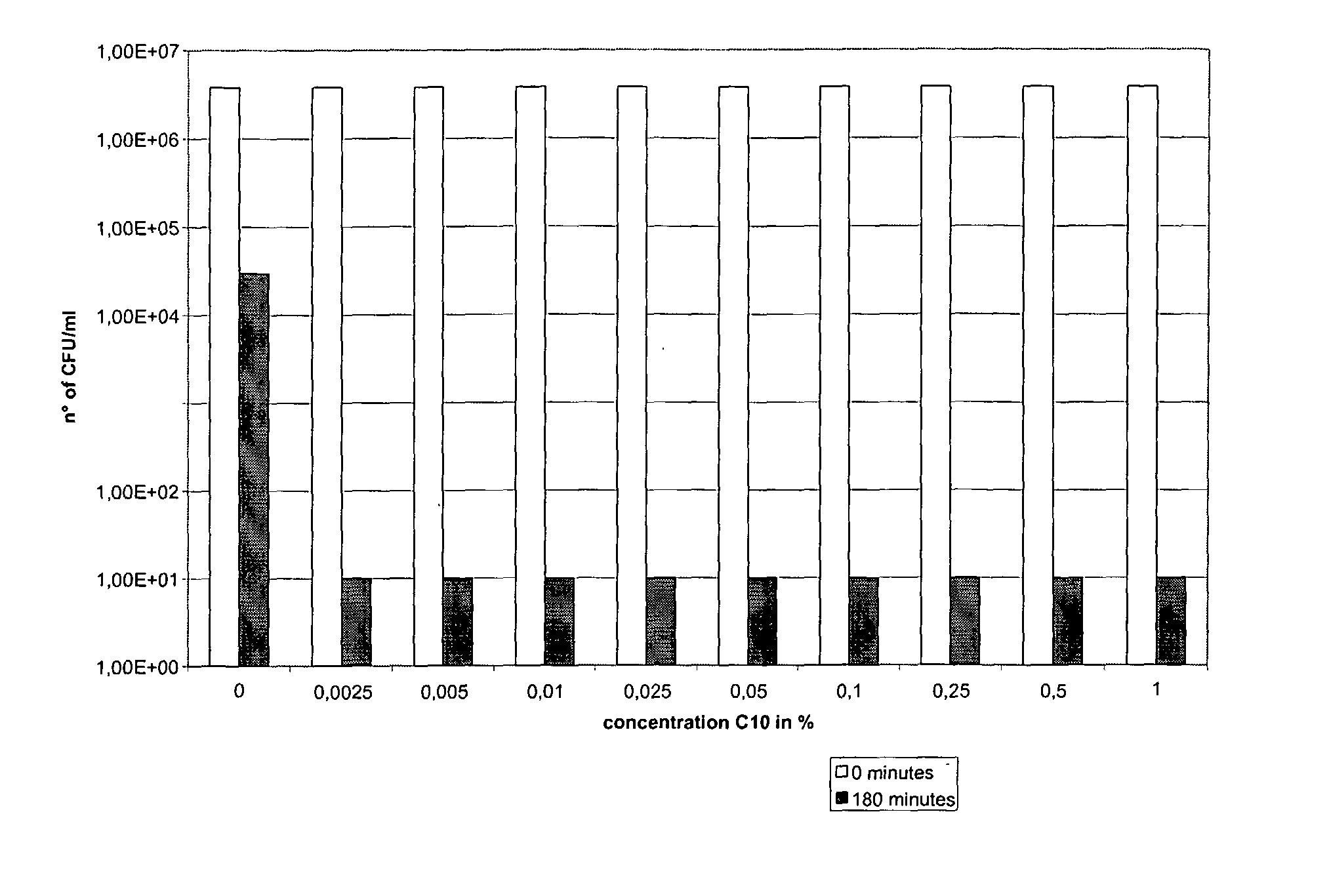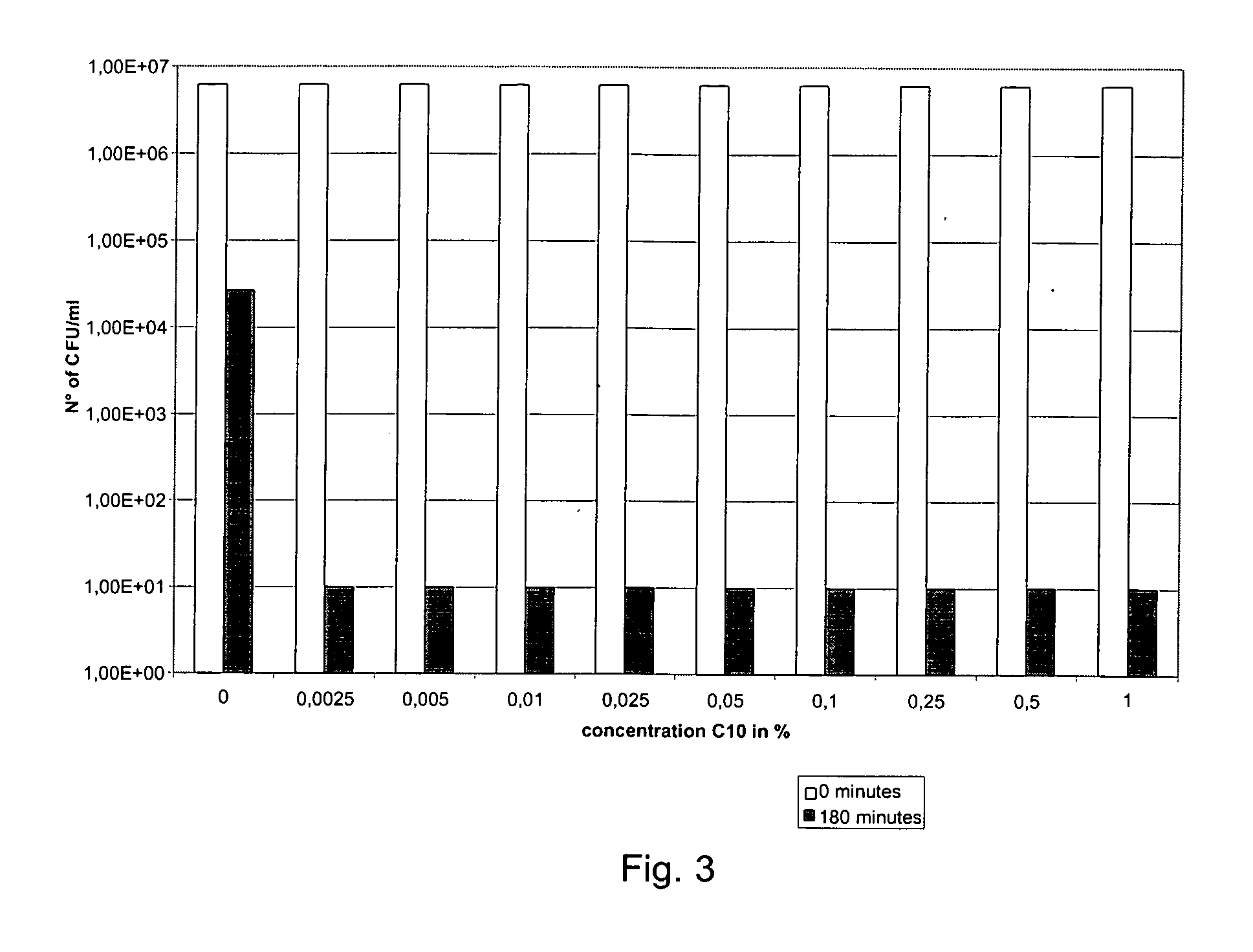Medium Chain Fatty Acids Applicable as Anti-Microbial Agents
a technology anti-microbial agents, applied in the field of medium chain fatty acids, can solve the problems of community high economic cost due to loss of working hours, high social and economic cost, and serious infection of campylobacter
- Summary
- Abstract
- Description
- Claims
- Application Information
AI Technical Summary
Benefits of technology
Problems solved by technology
Method used
Image
Examples
example 1
Influence of MCFA on Growth and Survival of C. jejuni and C. coli.
[0069] Eight Campylobacter strains were included in this study. Two strains (C. jejuni LMG 6444T / ATCC 33560 and C. coli LMG 6440T / ATCC 33559) were obtained from the BCCM™ / LMG Bacteria Collection (Ghent University, Ghent, Belgium). Six unrelated Campylobacter strains (5 C. jejuni and 1 C. coli), isolated from Belgian poultry products and identified at species-level by multiplex-PCR were also tested in this study. Three antibiogram control strains, S. aureus ATCC 25922, E. faecalis ATCC 29212 and E. coli ATCC 25923 were tested as well.
[0070] Three tenfold dilutions of a 10% suspension of the MCFA product (C6 and C8) were prepared in distilled water. C6 and C8 were used in equal amounts (50 / 50) by weight. The 10% suspension thus contains 5% C6 and 5% C8. To obtain the desired concentrations, 1.5, 0.75 and 0.36 ml of these dilutions were pipetted in petri dishes and carefully mixed with 15 ml molten growth medium. The m...
example 2
Influence of MCFA on Campylobacter, Salmonella, Escherichia and Enterococcus
[0072] Three tenfold dilutions of a 5% MCFA blend (C6 and C8) (stored at 7° C.) were prepared in distilled water. C6 and C8 were used in equal amounts (50 / 50) by weight. The 5% suspension thus contained 2.5% C6 and 2.5% C8. To obtain the desired concentrations, 1.5, 0.75 and 0.36 ml of these dilutions were pipetted in petri dishes and carefully mixed with 15 ml molten growth medium. The Mueller-Hinton II medium (BBL) with a pH of 7.2 was used.
[0073] Preserved strains (Campylobacter jejuni ATCC 33560 and Salmonella typhimurium DAB 76. Two antibiogram control strains, Enterococcus faecalis ATCC 29212 and Escherichia coli ATCC 25923) were grown in Brian Heart infusion broth. Inocula were prepared from overnight 16 to 26 h old broth cultures incubated at 37° C. These were obtained by suspending growth in sterile saline in a photometer adapted for McFarland scale measurements (bioMérieux). Solutions matching 0....
example 3
Influence of MCFA (C6-C8) on Salmonella-Infected Pigs
[0076] 43 piglets were divided into 3 groups: MCFA (C6-C8) (group A, n=16), a positive control group (group B, n=16) and a negative control group (group C, n=11). The trial started at weaning and lasted for 42 days after which all animals were euthaniased. In each pen of group A and B, 2 of the 4 piglets were experimentally inoculated with Salmonella ser. typhimurium before putting them with 2 non-infected piglets. Inoculation took place three days after weaning. MCFA (C6 and C8) supplemented feed (see feeds 1 and 2 below) was given from 3 days before inoculation until the end of the trial. C6 and C8 were used in equal amounts (50 / 50) by weight. Clinical score was measured 2 times a week by the same veterinarian. Therefore, following codes were given to the piglets: [0077] 0=normal alert pig responding to the observer entering the pen, normal behaviour, evades handling [0078] 1=dull, evades handling but only walked short distance...
PUM
| Property | Measurement | Unit |
|---|---|---|
| Fraction | aaaaa | aaaaa |
| Fraction | aaaaa | aaaaa |
| Fraction | aaaaa | aaaaa |
Abstract
Description
Claims
Application Information
 Login to View More
Login to View More - R&D
- Intellectual Property
- Life Sciences
- Materials
- Tech Scout
- Unparalleled Data Quality
- Higher Quality Content
- 60% Fewer Hallucinations
Browse by: Latest US Patents, China's latest patents, Technical Efficacy Thesaurus, Application Domain, Technology Topic, Popular Technical Reports.
© 2025 PatSnap. All rights reserved.Legal|Privacy policy|Modern Slavery Act Transparency Statement|Sitemap|About US| Contact US: help@patsnap.com



